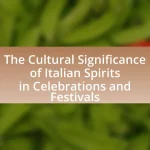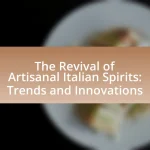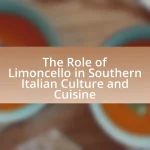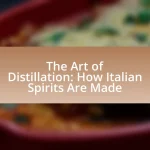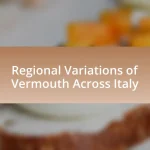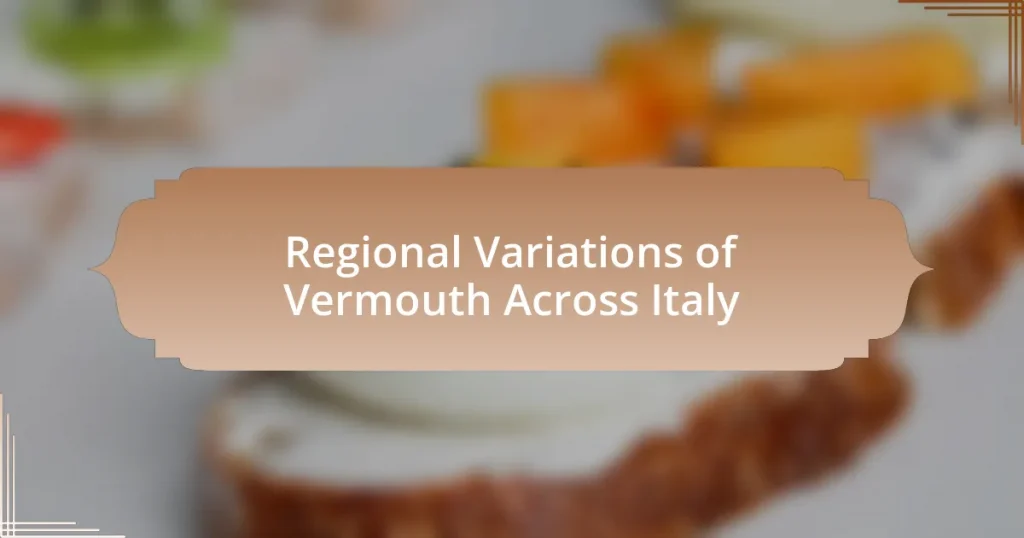The article explores the regional variations of vermouth across Italy, highlighting how local ingredients, traditions, and climate influence its production and flavor profiles. It details the distinct styles from regions such as Turin, Veneto, Liguria, and Sicily, each showcasing unique botanicals and production methods. Additionally, the article examines the historical context of vermouth, the evolution of traditional recipes, and the impact of cultural factors and tourism on its production. Key types of vermouth, tasting notes, and food pairing suggestions are also discussed, providing a comprehensive understanding of this diverse Italian beverage.

What are the Regional Variations of Vermouth Across Italy?
Vermouth varies significantly across Italy, with distinct regional styles reflecting local ingredients and traditions. In Turin, the birthplace of vermouth, the style is characterized by a sweet, aromatic profile, often infused with herbs and spices like wormwood and gentian. In contrast, the Veneto region produces a drier, more bitter vermouth, known for its use of local botanicals and a lighter body. The Liguria region offers a unique take with its use of coastal herbs, resulting in a fresher, more herbal flavor. Additionally, the Sicilian variant incorporates citrus notes, showcasing the island’s abundant citrus fruits. Each region’s vermouth not only highlights local agricultural products but also embodies the cultural heritage and preferences of its inhabitants.
How do different regions influence the flavor profiles of Vermouth?
Different regions influence the flavor profiles of Vermouth through variations in local botanicals, climate, and winemaking traditions. For instance, in Piedmont, the use of aromatic herbs like wormwood and the region’s unique climate contribute to a rich, complex flavor profile, often characterized by sweetness and herbal notes. In contrast, the coastal region of Liguria incorporates Mediterranean herbs and citrus, resulting in a lighter, fresher taste. Additionally, the historical practices of each region, such as the use of specific grape varieties and aging processes, further shape the distinct characteristics of Vermouth produced there. These regional differences are evident in the diverse styles, such as the dry Vermouth from Turin versus the sweeter versions from other areas, showcasing how geography and culture directly impact flavor.
What ingredients are unique to each region’s Vermouth?
Each region’s Vermouth in Italy features unique ingredients that reflect local flora and traditions. For example, Piedmont’s Vermouth often includes wormwood, gentian, and a variety of herbs and spices, while in Tuscany, ingredients like orange peel and cinnamon are more prevalent. In Veneto, the use of local botanicals such as juniper and cardamom is common, whereas in Liguria, the addition of aromatic herbs like basil and rosemary is distinctive. These regional variations are rooted in historical practices and the availability of local ingredients, contributing to the diverse flavor profiles of Italian Vermouth.
How does the production process vary by region?
The production process of vermouth varies significantly by region in Italy, influenced by local ingredients, traditions, and climate. For instance, in Piedmont, the use of high-quality wine and a diverse range of botanicals, including herbs and spices native to the region, is prevalent, resulting in a rich and complex flavor profile. Conversely, in Veneto, the production often emphasizes lighter, more aromatic styles, utilizing local white wines and a different selection of botanicals, reflecting the region’s unique agricultural offerings. Additionally, the aging process can differ; Piedmont vermouths may be aged longer in oak barrels, while those from other regions might focus on fresher, more vibrant characteristics. These regional distinctions are supported by the Denominazione di Origine Controllata (DOC) regulations, which dictate specific production methods and ingredient sourcing based on geographical location.
Why is the history of Vermouth significant in understanding its regional variations?
The history of Vermouth is significant in understanding its regional variations because it reflects the diverse cultural, agricultural, and climatic influences that shape its production in different areas. For instance, the origins of Vermouth in the late 18th century in Turin, Italy, established a foundation for the use of local herbs and spices, which vary by region. In contrast, the production methods and flavor profiles in regions like Piedmont, Lombardy, and Veneto showcase distinct local ingredients and traditions, such as the use of different grape varieties and botanical blends. Historical records indicate that these regional practices have evolved over time, influenced by local tastes and the availability of resources, thereby creating a rich tapestry of Vermouth styles across Italy.
What historical events shaped the production of Vermouth in Italy?
The production of Vermouth in Italy was significantly shaped by the emergence of herbal medicine practices in the 18th century, particularly in Turin, where the first commercial Vermouth was produced by Antonio Benedetto Carpano in 1786. This innovation was influenced by the growing interest in fortified wines and the use of botanicals for flavoring, which were prevalent in European medicinal traditions. Additionally, the unification of Italy in the 19th century facilitated the spread of Vermouth production techniques across different regions, leading to diverse local variations that incorporated regional herbs and spices. The establishment of Vermouth as a popular aperitif in the late 19th and early 20th centuries further solidified its cultural significance, with brands like Martini & Rossi and Cinzano gaining international recognition.
How have traditional recipes evolved in different regions?
Traditional recipes for vermouth have evolved significantly across different regions of Italy, reflecting local ingredients, cultural influences, and historical contexts. For instance, in Turin, the birthplace of vermouth, recipes often incorporate a blend of local herbs and spices, such as wormwood and gentian, which are essential for the distinct flavor profile. In contrast, the recipes from the Veneto region may emphasize sweeter profiles with the addition of fruits like cherries or oranges, showcasing the region’s agricultural products. Additionally, the use of different base wines, such as white or red, varies by region, influencing the final taste and color of the vermouth. Historical trade routes and local customs have also played a crucial role in shaping these variations, as seen in the use of unique botanicals that are specific to each area, further diversifying the traditional recipes.
What are the key types of Vermouth produced in various Italian regions?
The key types of Vermouth produced in various Italian regions include Vermouth di Torino, produced in Piedmont; Vermouth di Milano, originating from Lombardy; and Vermouth di Aosta, from the Aosta Valley. Vermouth di Torino is characterized by its rich flavor profile and is often sweet, while Vermouth di Milano is known for its bitter notes and herbal complexity. Vermouth di Aosta typically features local botanicals, giving it a unique taste reflective of the region’s terroir. These variations highlight the diverse production methods and ingredients used across Italy, contributing to the distinct characteristics of each type.
What distinguishes Sweet Vermouth from Dry Vermouth in regional contexts?
Sweet Vermouth is characterized by its sweetness and is often flavored with a variety of botanicals, while Dry Vermouth is more bitter and less sweet, typically featuring a lighter flavor profile. In regional contexts, particularly in Italy, Sweet Vermouth is predominantly produced in the northern regions, such as Piedmont, where it is often used in classic cocktails like the Negroni. Conversely, Dry Vermouth is more commonly associated with the southern regions, such as Sicily, where it is utilized in lighter aperitifs and cocktails. This distinction is rooted in local production methods and the types of botanicals available in each region, influencing the flavor and usage of each vermouth type.
How do local herbs and botanicals define each type of Vermouth?
Local herbs and botanicals are essential in defining each type of Vermouth, as they contribute unique flavors and aromas that reflect the region’s characteristics. For instance, in Turin, the use of artemisia and other local botanicals creates a distinctively bitter profile, while in Sicily, citrus peels and aromatic herbs like oregano impart a sweeter, more fragrant quality. These regional variations are rooted in local agricultural practices and cultural preferences, with specific herbs being traditionally associated with particular areas, such as the use of thyme in the production of Vermouth from the Piedmont region. This connection between local flora and Vermouth styles illustrates how geography and climate influence the final product, making each type of Vermouth a representation of its origin.
How do cultural factors influence Vermouth production in Italy?
Cultural factors significantly influence Vermouth production in Italy by shaping the ingredients, recipes, and consumption practices. Regional traditions dictate the selection of local herbs and botanicals, which vary from the Alpine regions to coastal areas, resulting in distinct flavor profiles. For instance, in Turin, the birthplace of Vermouth, the use of local wines and specific aromatic herbs reflects the city’s historical ties to the beverage. Additionally, cultural practices surrounding aperitivo, a social tradition in Italy, drive the demand for Vermouth, further influencing its production methods and marketing strategies. This interplay of local customs and historical context ensures that Vermouth remains a culturally significant product, tailored to regional tastes and preferences.
What role do local festivals and traditions play in Vermouth production?
Local festivals and traditions significantly influence Vermouth production by promoting regional ingredients and unique recipes. These events often celebrate local heritage, showcasing specific botanicals and production methods that reflect the area’s culture. For instance, festivals like the “Festa del Vermouth” in Turin highlight the city’s historical connection to Vermouth, encouraging local producers to innovate while adhering to traditional practices. This interplay between celebration and production fosters a sense of community and preserves the artisanal techniques that define regional variations of Vermouth across Italy.
How does regional cuisine pair with different types of Vermouth?
Regional cuisine pairs with different types of Vermouth by complementing the unique flavors and ingredients characteristic of each region. For instance, the herbal and bitter notes of a dry Vermouth from the Piedmont region enhance the flavors of local dishes like vitello tonnato, while the sweeter, spiced profiles of a red Vermouth from Tuscany can elevate the taste of rich pasta sauces and grilled meats. This pairing is supported by the tradition of using local ingredients in both Vermouth production and regional cooking, creating a harmonious balance that reflects the culinary heritage of Italy.
What are the current trends in Vermouth production across Italy?
Current trends in Vermouth production across Italy include a resurgence of artisanal methods, a focus on local botanicals, and an increase in the popularity of dry and low-sugar varieties. Artisanal producers are reviving traditional recipes and techniques, emphasizing quality and craftsmanship. Additionally, there is a growing interest in using indigenous herbs and spices, which enhances regional characteristics and flavors. The market is also seeing a shift towards dry vermouths, reflecting consumer preferences for less sweet options, with brands like Martini & Rossi and Carpano adapting their offerings to meet this demand.
How are modern producers innovating traditional Vermouth recipes?
Modern producers are innovating traditional Vermouth recipes by incorporating unique local botanicals and experimenting with unconventional flavor profiles. For instance, some producers in Italy are using indigenous herbs and spices that reflect their specific regional terroir, such as the use of citrus peels in coastal areas or wildflowers in mountainous regions. This approach not only enhances the complexity of the Vermouth but also creates a distinct identity tied to its origin. Additionally, advancements in production techniques, such as cold extraction methods and the use of organic ingredients, are being adopted to preserve the freshness and authenticity of flavors, further differentiating modern Vermouth from its traditional counterparts.
What impact does tourism have on regional Vermouth production?
Tourism significantly boosts regional Vermouth production by increasing demand for local products and enhancing the visibility of traditional production methods. As tourists visit regions known for their Vermouth, such as Piedmont, they often seek authentic experiences, leading to higher sales in local distilleries and wineries. For instance, the rise in agritourism has encouraged producers to offer tastings and tours, which not only educate visitors about Vermouth’s heritage but also promote local consumption. This interaction between tourism and production fosters a cycle where increased interest leads to greater investment in quality and innovation within the Vermouth industry, ultimately benefiting the local economy and preserving traditional practices.
How can consumers appreciate the regional variations of Vermouth?
Consumers can appreciate the regional variations of Vermouth by exploring the unique ingredients, production methods, and flavor profiles specific to each Italian region. For instance, Vermouth from Turin often features a blend of aromatic herbs and spices, while Sicilian Vermouth may incorporate citrus and Mediterranean botanicals, reflecting local agricultural practices. Understanding these distinctions enhances the tasting experience, allowing consumers to recognize how geography influences flavor. Additionally, participating in tastings or visiting local producers can provide firsthand insight into the craftsmanship and regional characteristics that define each type of Vermouth.
What tasting notes should one look for in different regional Vermouths?
Different regional Vermouths in Italy exhibit distinct tasting notes influenced by local botanicals and production methods. For example, in Turin, the Vermouth often features rich flavors of herbs, spices, and a hint of sweetness, with prominent notes of wormwood and citrus. In contrast, the Vermouth from Sicily tends to be more aromatic, showcasing notes of orange peel, almonds, and Mediterranean herbs, reflecting the island’s climate and flora. Additionally, the Vermouth from the Veneto region may present a more bitter profile, with tasting notes of gentian root and various spices, emphasizing a drier finish. These variations are rooted in the unique agricultural practices and cultural influences of each region, making Italian Vermouth a diverse and complex category.
How can one best pair regional Vermouth with food and cocktails?
To best pair regional Vermouth with food and cocktails, one should consider the specific flavor profiles and characteristics of each type of Vermouth. For example, dry Vermouth from the Piedmont region complements seafood dishes due to its herbal notes, while sweet Vermouth from Tuscany pairs well with rich meats and cheeses, enhancing their flavors. Additionally, cocktails like the classic Martini benefit from the use of dry Vermouth, while Negronis are elevated by sweet Vermouth, showcasing the versatility of these regional variations. The historical context of Vermouth production in Italy, which dates back to the 18th century, further supports the idea that local ingredients and traditions influence these pairings, making them more authentic and enjoyable.
